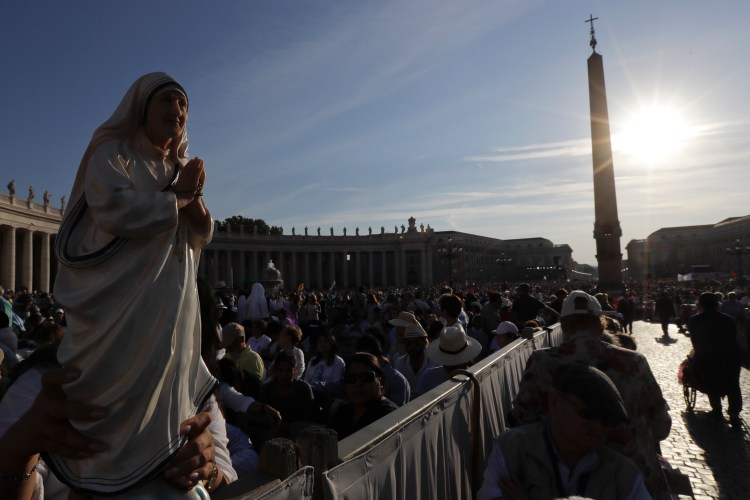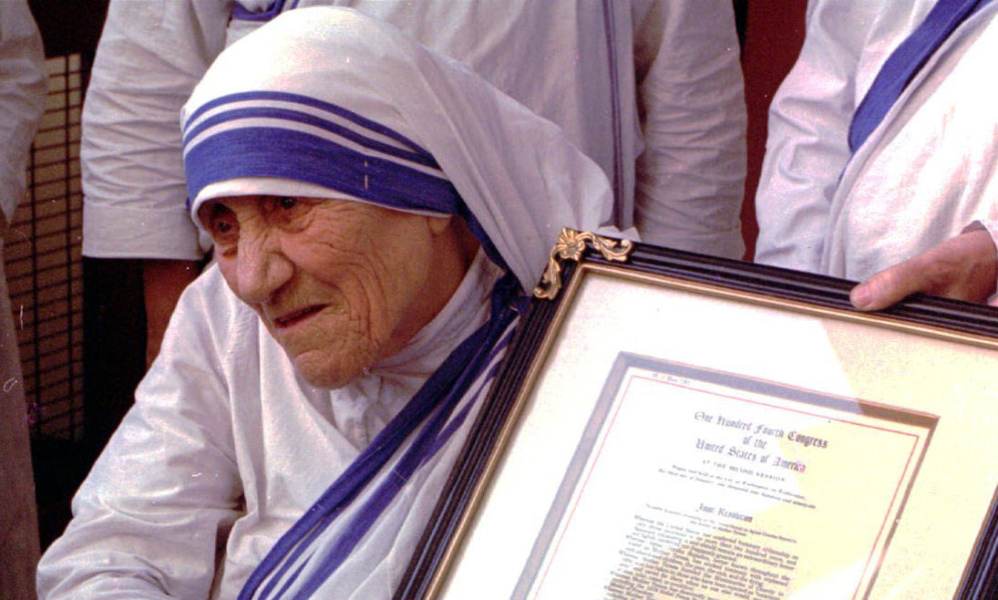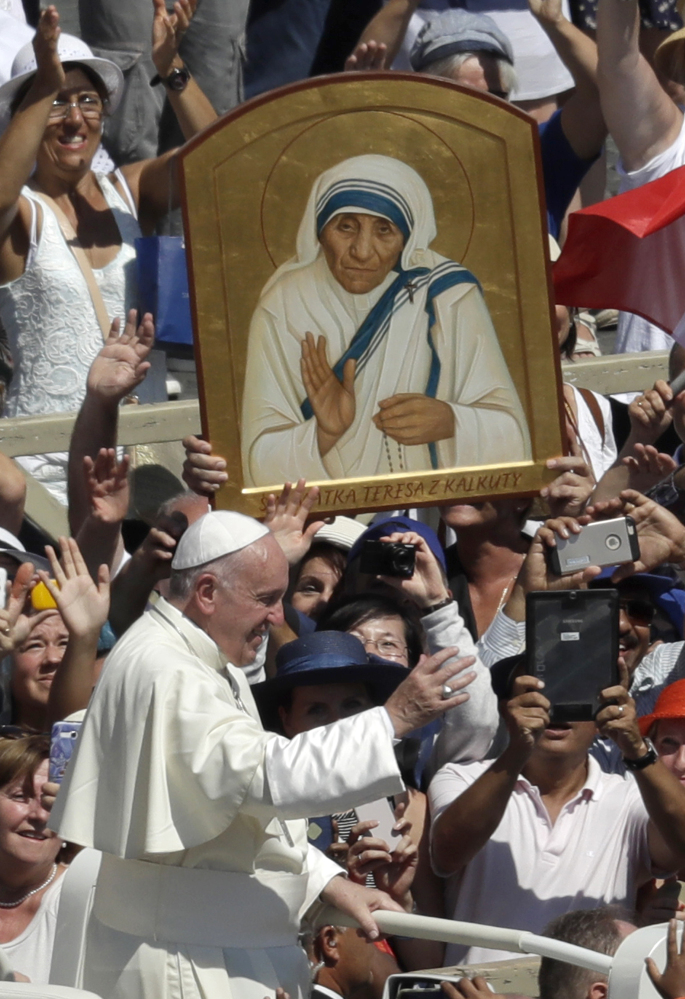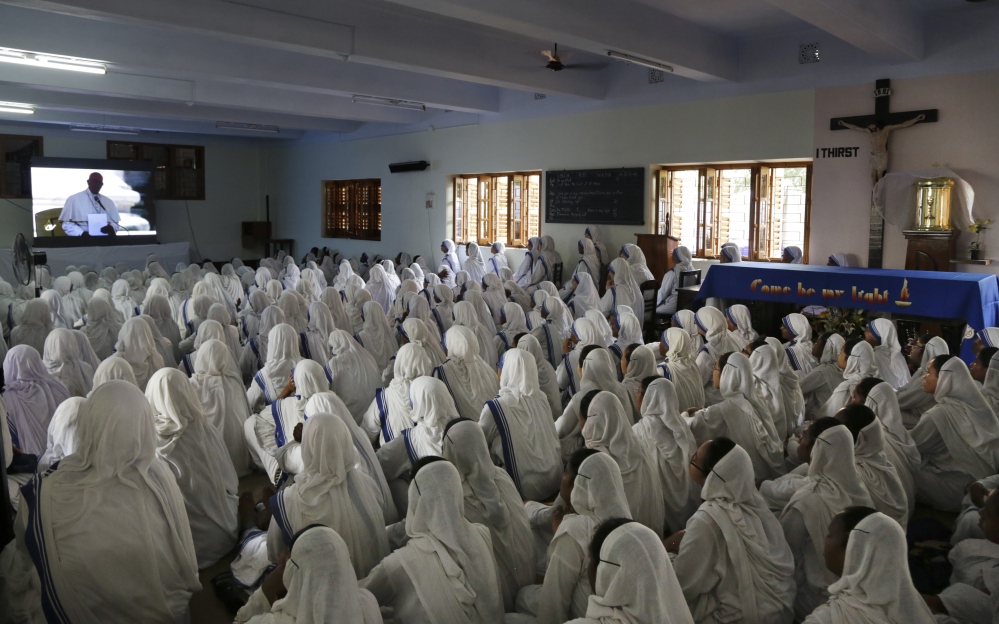KOLKATA, India — With solemn prayer mixed with joyful songs, Christians in the Indian city of Kolkata celebrated the sainthood of Mother Teresa on Sunday, honoring the nun who worked tirelessly for the poor here and indelibly shaped the city’s image in the eyes of the world.
A crowd of about 300 gathered outside the narrow lane leading to the modest Mother House of the order that Mother Teresa founded. They listened to a short service and watched the proceedings from Rome on a large television screen.
Inside, dozens of nuns – clad in the simple white-and-blue-trimmed sari of the order – also watched. They applauded as Pope Francis read in Latin the proclamation declaring Mother Teresa a saint and as her photo slowly unfurled over St. Peter’s Square.
An estimated 120,000 people filled St. Peter’s Square for the canonization ceremony. It was the highlight of Francis’ Holy Year of Mercy and quite possibly one of the defining moments of his mercy-focused papacy.
Francis has been dedicated to ministering to society’s most marginal, from prostitutes to prisoners, refugees to the homeless. In that way, while the canonization of “St. Teresa of Kolkata” was a celebration of her life and work, it was also something of an affirmation of Francis’ own papal priorities, which have earned him praise and criticism alike.
In Kolkata, some wept for joy.
“I’m feeling so lucky to have witnessed this. I’m overwhelmed,” said Sumitra Elizabeth Mondal, 26, a teacher in the tutoring center, who had burst into tears.
The nuns said they were happy this day had finally come – although, in their minds, the small Albanian woman who radiated strict love was saintly already.
“It’s not becoming a saint. She was always a saint,” said Sister Nicole, who oversees the order’s home for the destitute and dying in a clamorous temple neighborhood in Kolkata, once known as Calcutta. “Now she’s just recognized and proclaimed.”
They came with floral bouquets and placed them by a photo. The nuns also celebrated a thanksgiving service in her honor. Towering images of Mother Teresa were on billboards around the city, illuminated by lights. The celebrations were muted partly because the city plans its own program honoring her life next month.
Although Mother Teresa was revered here in this sprawling megacity of 14 million because of her work with the poor, the dying, orphans and leprosy patients, many Kolkatans – and indeed, many in India – feel ambivalent about her legacy.
After she won the Nobel Prize in 1979, some believe, she cast a long shadow over the city’s history, obscuring its vibrant cultural past with an image of a place teeming with dead bodies in gutters. The city of wide boulevards, crumbling buildings and quirky neighborhoods has long fostered some of the most important writers, artists and intellectuals in India – including filmmaker Satyajit Ray and the Nobel Prize-winning poet Rabindranath Tagore.
The novelist and journalist Sandip Roy, who spent 20 years in San Francisco before moving back home to Kolkata in 2011, said the Mother Teresa narrative obscured other facets of the complicated city he grew up in – its vociferous soccer clubs, fish markets and busy cafes.
“She was a presence definitely as I was growing up. But it wasn’t until I moved to the West that I realized she overshadowed everything else in people’s perception of Calcutta,” he said. “It was a city where she lived, but it was not Mother Teresa’s city.”
The ethnic Albanian Agnes Gonxha Bojaxhiu was born in 1910 Skopje, now the capital of Macedonia. She arrived in 1929 to teach high school as a young nun in the Loretto order and eventually secured permission from the Vatican to found her own order, the Missionaries of Charity.
She founded her first school under a tree in a Kolkata slum in 1949 and three years after that the religious order that now includes more than 4,500 nuns and brothers in about 130 countries.
After the Nobel Prize, her fame grew and she embraced an international role traveling the world to speak against abortion and contraception. She was criticized by former volunteers and others who became disillusioned with frayed conditions of many of her centers, even as millions in donations rolled in.
She once said: “We are not social workers, not teachers, not nurses or doctors; we are religious sisters. We serve Jesus in the poor. Our life has no other reason or motivation. This is a point many people do not understand.”
Within India in recent years, the Hindu right wing has also criticized her for conversion – a charge her supporters deny.
The elegant Kolkata artist Sunita Kumar knew the nun since 1967, when she met her while volunteering to make medicine packets for leprosy patients. She went on to serve as Mother Teresa’s spokeswoman until the nun died in 1997.
She said Mother Teresa was a “very much revered” figure in the city. Her car would be rushed by those seeking her blessings when she was at stoplights.
She also had a sense of humor, Kumar recalled. Once, when passing the Victoria Memorial Hall, the cavernous city icon built by the British as an homage to Queen Victoria, she leaned over to Kumar and said, “Why don’t they give me this monument to house my poor?”
On Sunday, Lincoln James Gomes, a 38-year-old Christian, waited with his mother, wife and child in a muggy monsoon heat to enter the Mother House – where Mother Teresa lived in a simple room – to pray by her marble tomb.
He remembered his mother bringing him as a child to seek the blessings of the nun, who patted his head and lightly ruffled his hair. Now, he said, “we just want to pay tribute to her.”
At the first school she founded in the Motijheel slum area of the city, which now does after-school programs, boys playing with handmade kites in the trash-strewn field out back were unaware of her legacy.
Inside, 13-year-old Joyti Bhuinya scooped water on a statue of the Virgin Mary as the school readied for its own program.
“She’s becoming a saint so she can finish her work in heaven,” the girl said.
The Associated Press contributed to this report.
Send questions/comments to the editors.






Success. Please wait for the page to reload. If the page does not reload within 5 seconds, please refresh the page.
Enter your email and password to access comments.
Hi, to comment on stories you must . This profile is in addition to your subscription and website login.
Already have a commenting profile? .
Invalid username/password.
Please check your email to confirm and complete your registration.
Only subscribers are eligible to post comments. Please subscribe or login first for digital access. Here’s why.
Use the form below to reset your password. When you've submitted your account email, we will send an email with a reset code.